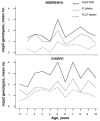Transmission-dependent tolerance to multiclonal Plasmodium falciparum infection
- PMID: 19702508
- PMCID: PMC2741682
- DOI: 10.1086/605652
Transmission-dependent tolerance to multiclonal Plasmodium falciparum infection
Abstract
Whether the number of concurrent clones in asymptomatic Plasmodium falciparum infections reflects the degree of host protection was investigated in children living in areas with different levels of transmission on the coast of Kenya. The number of concurrent clones was determined on the basis of polymorphism in msp2, which encodes the vaccine candidate antigen merozoite surface protein 2. In a low-transmission area, most children had monoclonal infections, and diversity did not predict a risk of clinical malaria. In an area of moderate transmission, asymptomatic infections with 2 clones were, compared with 1 clone, associated with an increased risk of subsequent malaria. In a comparative assessment in a high-transmission area in Tanzania, multiclonal infections conferred a reduced risk. The different nonlinear associations between the number of clones and malaria morbidity suggest that levels of tolerance to multiclonal infections are transmission dependent as a result of cumulative exposure to antigenically diverse P. falciparum infections.
Figures




References
-
- Snow RW, Omumbo JA, Lowe B, et al. Relation between severe malaria morbidity in children and level of Plasmodium falciparum transmission in Africa. Lancet. 1997;349:1650–4. - PubMed
-
- Babiker HA, Lines J, Hill WG, Walliker D. Population structure of Plasmodium falciparum in villages with different malaria endemicity in east Africa. Am J Trop Med Hyg. 1997;56:141–7. - PubMed
-
- Arnot D. Unstable malaria in Sudan: the influence of the dry season. Clone multiplicity of Plasmodium falciparum infections in individuals exposed to variable levels of disease transmission. Trans R Soc Trop Med Hyg. 1998;92:580–5. - PubMed
-
- Konate L, Zwetyenga J, Rogier C, et al. Variation of Plasmodium falciparum msp1 block 2 and msp2 allele prevalence and of infection complexity in two neighbouring Senegalese villages with different transmission conditions. Trans R Soc Trop Med Hyg. 1999;93(Suppl 1):21–8. - PubMed
-
- Bendixen M, Msangeni HA, Pedersen BV, Shayo D, Bodker R. Diversity of Plasmodium falciparum populations and complexity of infections in relation to transmission intensity and host age: a study from Usambara Mountains, Tanzania. Trans Roy Soc Trop Med Hyg. 2001;95:143–8. - PubMed

